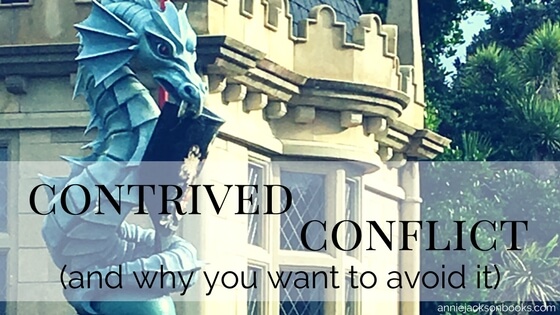Conflict is the life blood of drama. YA authors gleefully thrive on the tears and broken hearts of their readers. Readers wail and cry and tweet and then come back, hungry for more. But contrived conflict is another matter altogether. It destroys your reader’s trust and dare I even say it has the potential to ruin your story.
Contrived conflict, in essence, is when the conflict is more important than the other pieces of your story.
I also like the term chasing conflict, because that’s what it feels like the writer is doing – chasing some conflict they want to happen in their story. Because they think they need it. Or because they think it will shock readers. Or simply because they really like it.
You see it in tv the most – because they need conflict for each episode and so the need for that episode’s conflict becomes more important than the integrity of the characters or the overall story (sometimes whether they know it or not).
When characters are sacrificed for conflict
You know what I mean, don’t you! Because you’ve read that book where the character does something totally stupid just to create conflict for 50 pages and get the book to the needed word count. Or the character believes some ridiculous lie so that they’re at odds with other characters. You’ve watched the tv show where they force the couple apart season after season. At first, maybe, it makes sense. They have well grounded, logical reasons not to be together. But then, eventually, you start rolling your eyes at all the ways they’ve contrived to prolong the courtship.
Characters aren’t always sacrificed to keep people apart, however. They’re used as pawns, acting out of their nature to contrive some new conflict. They make choices that make absolutely no sense. And more times than not their way back from some ludicrous choice involves the 4 worst words in any story.
This doesn’t mean abandon the conflict you really like. It means, if you’re going to have a character act out of their nature, make sure you give them a very good reason.
Think through how your character would react and set all the pieces in place to justify their choice (either based on mental logic or emotional logic). Your story will be stronger and your conflict more poignant if it doesn’t betray your characters.
When rules are broken for conflict
Characters aren’t the only thing sacrificed for conflict. The rules of the world are broken all the time in stories for nothing more than contrived conflict.
There are two great things about rules, however. The first is that the writer created them. They can, therefore, change them. Depending on where you are in the publishing cycle, if you really like the conflict then go back and change the rules to accommodate it.
I did this for Enchanted Storms when I came up with the idea for the fairie storm. It didn’t quite make sense with the rules I’d established in the relationship between our world and fairie, so I changed the rules. Because I really liked that storm.
If the rules are already canon then the second great thing is that writers can break them, perhaps better than anyone else. It’s like that quote about playing the piano, “Love is like playing the piano. First you must learn to play by the rules. Then you must forget the rules and play from your heart.”
When it’s contrived, the audience can tell when you’ve broken a rule or rewritten it just for the sake of some conflict.
Don’t be afraid to break the rules. Change the rules. Create fissures in the fabric of your world that change all the rules. The key, again, is to do it in a way that makes sense.
When conflict breaks promises to the reader
I think few writers intentionally make promises to the audience. One might think promises are limited to flash forwards or prophecies that the writer then needs to deliver on. But they’re not.
Writers make promises to the audience with their theme. Theme is one of those tricky things – with different interpretations and no hard and fast way to define the theme in a given story. I think of the theme as the story’s world view. What are they saying about how the world works? About how people interact with one another. About how to live life. Consciously or not, the reader will expect certain things from your characters and your world based on the world view the story offers them.
Writers make promises with their characters. ‘This is what this person believes in, what they stand for, how they will make their choices.’ Naturally, the audience then expects them to act in accordance with those choices.
You can use those expectations, logically defy them to surprise readers. Or you can undermine your theme entirely with a conflict that turns everything you’ve been saying thus far into a lie.
So, honor the relationship with the audience and what you’re asking them to believe. Be consistent with the world view you’re portraying or be smart in subverting it.
Authentic Conflict
So the lesson is this: create conflict, do not chase it. Maintain the integrity of your characters in each conflict. People have divergent goals and differing perspectives enough, you don’t need to contrive conflict for them. And be aware of what you’re asking your audience to believe – about your characters and about the world. Then don’t undercut your own message, especially not for the sake of conflict.
Storytellers create conflict. People want different things. People like different things. People see the world differently. Illness, fire, earthquake, famine. There is conflict enough for any story.
Chasing conflict feels inauthentic and your audience can tell when you’re doing it.



